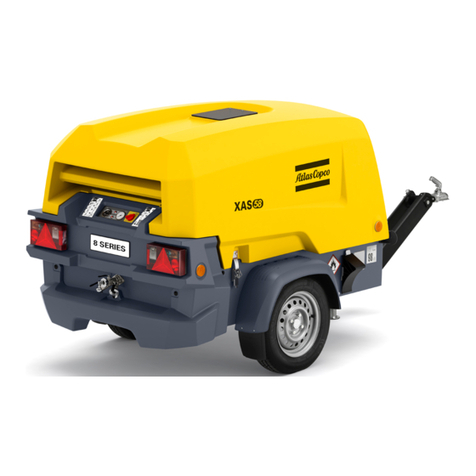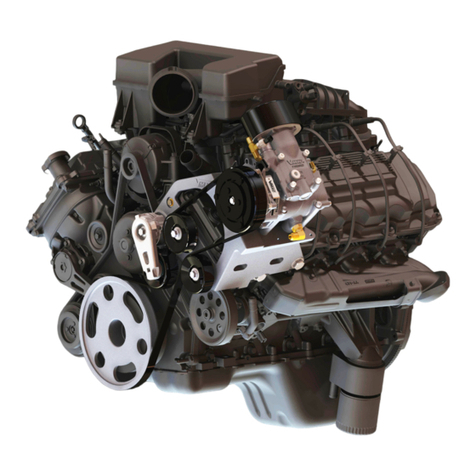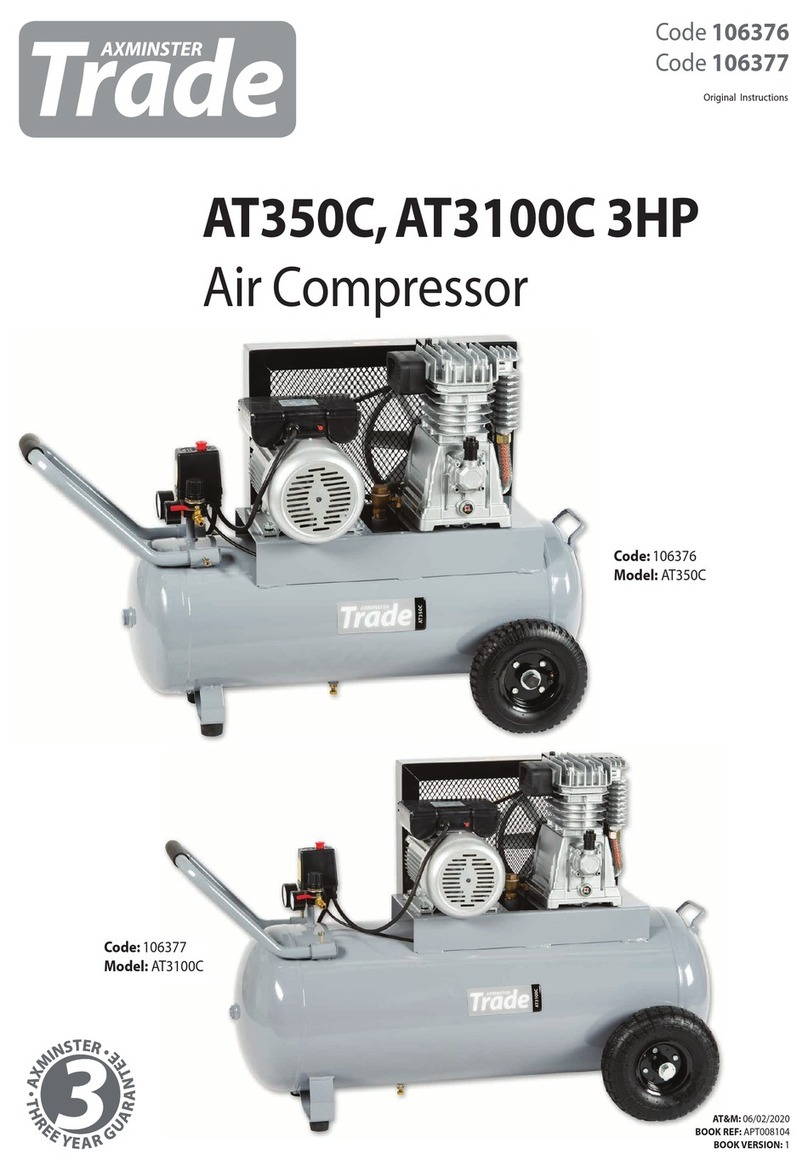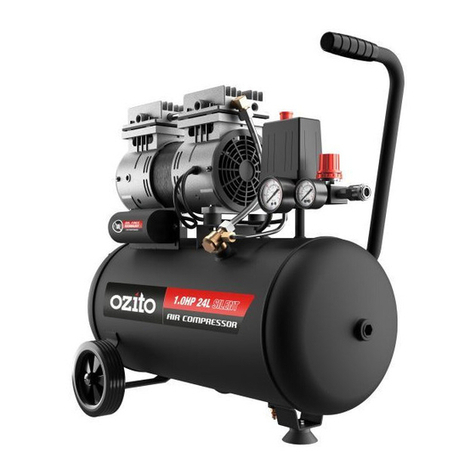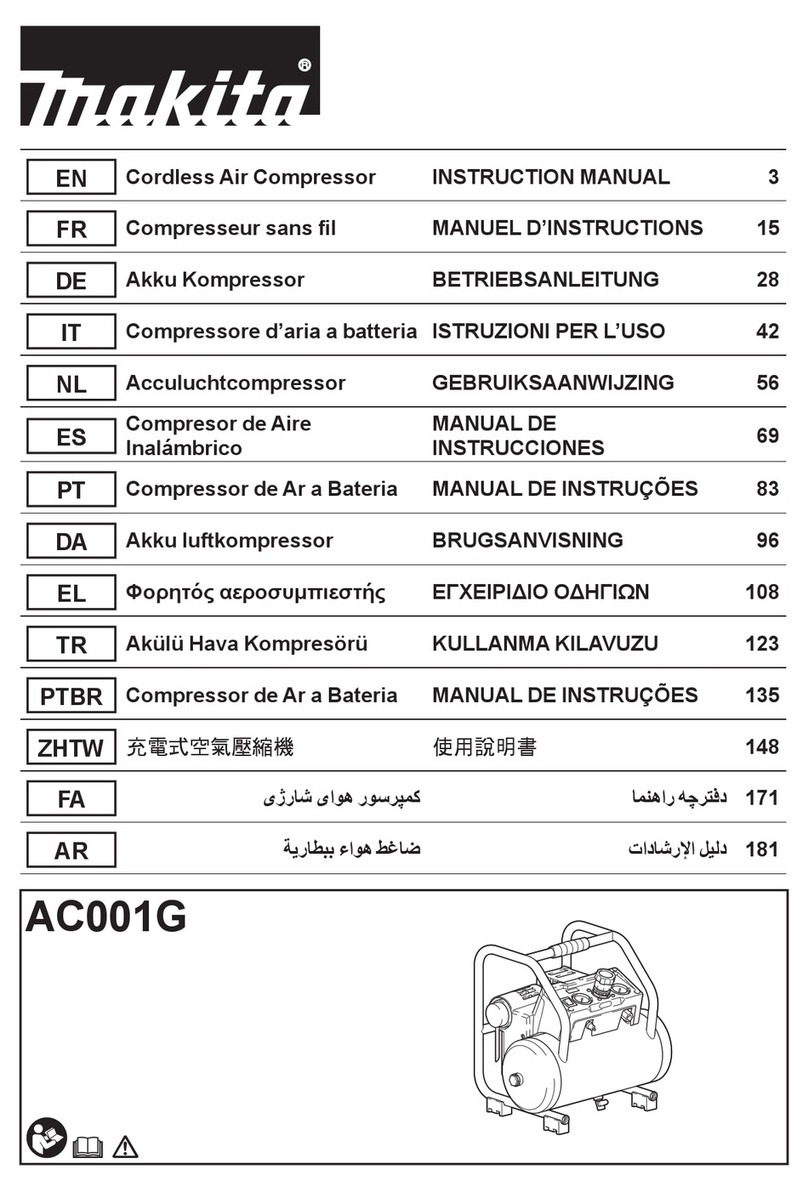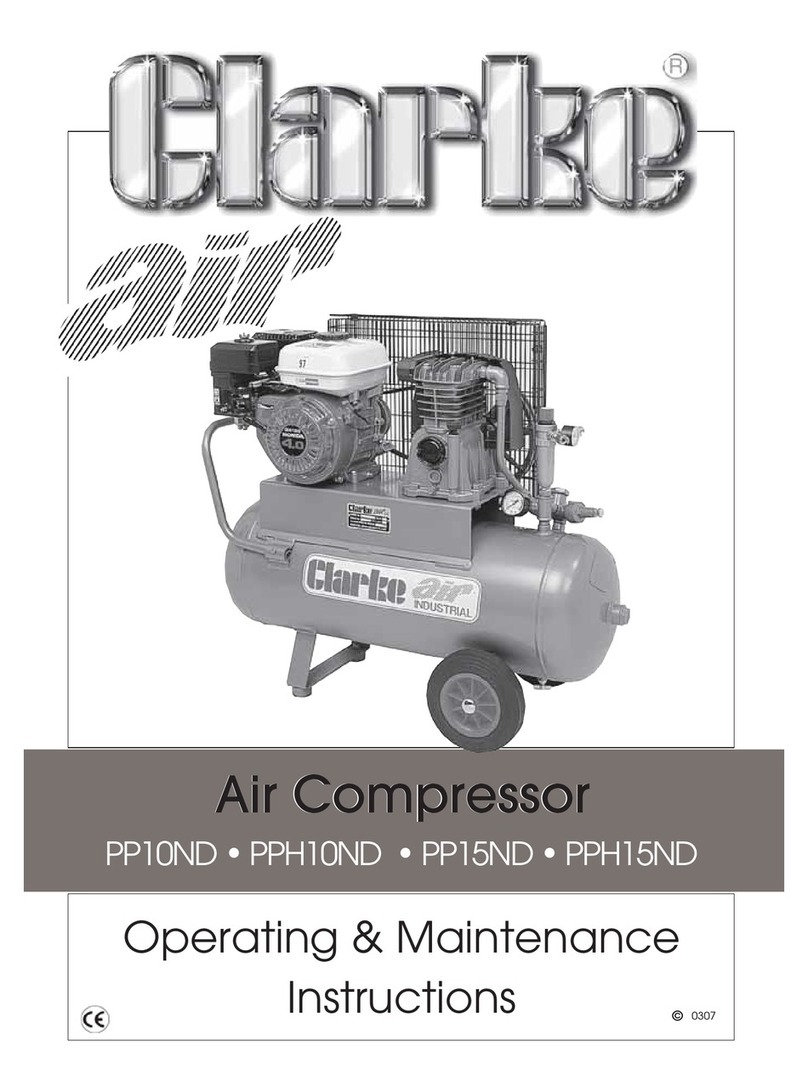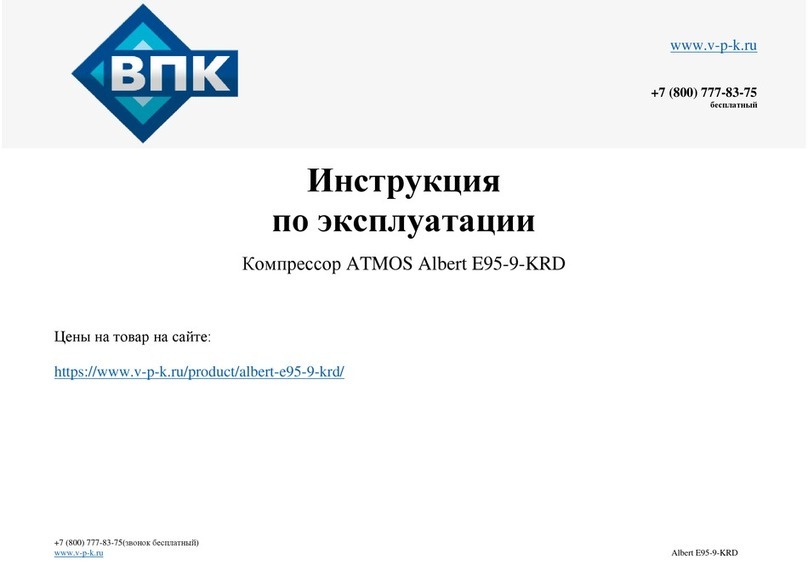JBL 7110 User manual

BEFORE PROCEEDING WITH COMPLETE UNPACKING AND SETUP
PLEASE READ THE SECTION ON UNPACKING AND INSPECTION
UBL UREI
ELECTRONIC
PRODUCTS
model 7110
LIMITER/COMPRESSOR
JBL Incorporated
8500 BALBOA BOULEVARD
P.O. BOX 2200
NORTHRIDGE, CA. 91329 USA
PHONE: (818 >893-8411
TELEX: 4720424
©Copyright 1988, JBL Incorporated

Table of Contents
Section One Introduction 1
1.1 Preface 1
1.2 Unpacking and Inspection 1
1.3 About this Manual 1
1.4 Front Panel 2
1.5 Rear Panel 3
Section Two Installation 4
2.1 AC Power Connection &Line Voltage Conversion 4
2.2 Grounding 5
2.3 Mounting 5
2.4 Input Connections 6
2.5 Output Connections 6
2.6 Using Floating or Balanced Cables for Longer Runs 7
2.7 Impedance and Termination for 600 Ohm Lines 7
2.8 Output Level Reference Trim 8
2.9 Security Cover 8
2.10 Installation of Optional Output Transformer 9
Section Three Operation/Application 9
3.1 Turn On Procedure 9
3.2 Compressors and Limiters -Definitions and Functions 9
3.3 Getting Started 1
3
3.4 The Auto Switch 1
3
3.5 Linking Multiple Limiters 14
3.6 Using the Direct Input to the Gain Reduction Control Amplifier 1
4
Section Four Theory of Operation 1
5
4.1 Input Amplifer 15
4.2 Gain Reduction VCA 1
5
4.3 Output Amplifier 1
5
4.4 Gain Reduction Control Amplifier 1
5
4.5 Relay Circuit 15
4.6 Input/Output Display 1
6
4.7 Gain Reduction Display 16
4.8 Power Supply 16
Section Five Maintenance 17
5.1 General 17
5.2 Repairs and Warranty 17
Section Six Specifications 18

JBUUREI MODEL 7110
Section One Int roductiQD
1
.1
Preface
Thank you for purchasing this JBL/UREI product. We have prepared this instruction manual
to enable you to achieve optimum utility and performance from your new Limiter/Compressor.
We encourage you to read and to make use of the material contained in this manual. We
welcome your suggestions and comments on our products and on this manual.
This manual is dedicated to all the people who are interested in learning about the
capabilities and limitations of our products in order to best use them. Learn, Enjoy and
Share.
1.2 Unpacking and Inspection
Your new JBL/UREI Limiter/Compressor was carefully packed at the factory, and the con-
tainer was designed to protect the unit during shipment. Nevertheless, we recommend
careful examination of the shipping carton and its contents for any sign of physical damage
which may have occurred in transit.
If damage is evident, do not destroy any of the packing material or the carton, and
immediately notify the carrier of apossible claim for damage. Damage claims must be made
by you.
The shipping carton should contain:
The JBL/UREI Model 7110 Limiter/Compressor
This Instruction Manual
An envelope containing Rack Mounting Hardware
1.3 About this Manual
The diagrams and information on the following few pages provide an overview of the
controls, indicators and connectors of the Model 7110 Limiter/Compressor. For those already
experienced in the use of Compressors and Limiters, these few pages should be enough to
get you “up and running.” Additional detailed information follows in the Installation,
Operating/Application, and Theory of Operation sections. No matter what your level of
expertise, we encourage you to look through this manual to gain abetter understanding of
how this product works, and how it will help you with the task at hand.
Note: In this manual, unless otherwise specified, 0dBu is equivalent to 0.775 volts and 0
dBm is one milliwatt in acircuit with aload impedance of 600 ohms.
Page 1

JBUUREI MODEL 7110
1.4 Front Panel
IREI
LECTRONIC
RODUCTS THM
:
?
IHOlO
•M
p- AU
OAWflCOUeTlON
m
Dcn
1
J*
1
oooooooooocooooo
CTOR ATTACK MU
t\/ V *
?'
,Mfr'l'lkO* MOirf^ j
AM RA1
.lAl' 1LiVlL oooccooocoooooco
OUmiTUVEL
uvitoitRLAv C
MWT ri OUTPUT
MODE
UMITCR/COMPRE
1
^
L7110
SSOR
\/1
ABCDEFGHI JK LM
Figure 1-The Front Panel
A. LINK Switch
Depress this switch to strap multiple units together for gain reduction tracking. An LED
indicates that the switch is depressed. See Section 3.5.
B. THRESHOLD Conlroi
Adjusts the level at which gain reduction begins.
C. GAIN REDUCTION Display
16 Segment LED display indicates the amount of gain reduction in dB.
D. AUTO Switch
Auto ON presets the Detector, Attack and Ratio controls and engages aprogram dependent
Release circuit. An LED indicates that the switch is depressed.
E. DETECTOR Control
Adjusts the peak detector threshold from 0to 20 dB above the average detector threshold.
F. ATTACK Control
Adjusts the attack time of the average detector from 1millisecond at full CCW rotation to
50 milliseconds at full CW rotation.
G. RELEASE Control
Adjusts the release time constant from 50 milliseconds to 2seconds for 10 dB of release.
H. RATIO Control
Controls the relationship of the change in input level to the change in output level.
I. SIGNAL LEVEL Display
16 segment LED display Indicates input or output level.
Page 2

JBUUREI MODEL 7110
J. LEVEL DISPLAY Switch
Switches the signal level display to show either Input or Output Level. Two LEDs indicate the
switch position.
K. OUTPUT LEVEL CoDlrol
Changes output level ±20 dB.
L. Output Level Reference Trim
Front panel adjustment of “zero reference” for the output level display. “0” may be set from -
10 to +8 dBu. See Section 2.8.
M. Power Switch
Push to turn the unit on. Push again to turn the unit off. One or more status indicator LEDs
will be on when the unit is powered up. After the power is switched on, there is a3second
delay before any processed signal is passed through the unit. During this time, and at any
time power is off, the input signal is passed directly to the output.
1.5 Rear Panel
A. AC Line Cord
B. Line Voltage Select Switch (7110EX export model only)
Selects Line Voltage of nominal 100, 120 or 220/240 VAC. See Section 2.1.
The unbalanced output is available at the male XL- type connector, the 1/4 inch phone jack
and/or at the terminals of the barrier strip. The output may be converted to floating, balanced
with an optional output transformer. See Section 2.5 for pinout and 2.10 for instructions on
installing the optional transformer.
Page 3

JBUUREl MODEL 7110
D. Signal Ground
The signal ground is available at the output terminal strip (GND), at the input barrier strip, at
the ring and sleeve of the phone jacks and pin 1of the XL connectors. This is the ground
common to all the internal analog circuitry.
E. -Lials
Two or more 7110s may be linked together for gain reduction tracking through the Link
terminal. This is ahigh impedance point, and shielded cable should be used. See
Section 3.5.
F. Chassis Ground
The chassis ground is connected to the mechanical ground pin of the AC line plug, and is
connected to signal ground (GND) via a1000 ohm resistor, a0.1 microfarad capacitor, and a
removable barrier strip jumper, all in parallel. The jumper may be removed if it is necessary
to isolate signal ground from chassis ground. See Section 2.2.
G. Detector
This is the input to the Gain Reduction detector and is normalled from the audio input
connectors. Balanced or unbalanced signals may be connected through the 1/4 inch phone
jack in the same manner as normal audio signals. Tip is ring is and sleeve is ground.
See Section 3.6.
H. Input Signal
The input signal can be applied at the female XL-type connector (pin 3pin 2the 1/4
inch phone jack (tip is “+”, ring is and sleeve is ground), and/or at the “+” and terminals
of the barrier strip. Either balanced or unbalanced inputs are acceptable.
Section Two Installation
2.1 AC Power Connection &Line Voltage Conversion
There are two versions of the Model 7110. The standard 7110 can be powered from nominal
120 VAC, 60 Hz mains as found in the USA. The 7110 has no Supply Voltage Select Switch
on the rear panel, and may be plugged into any standard 120 VAC grounded receptacle.
The 71 10EX export model is equipped with athree-position Supply Voltage Select Switch
on the rear panel which allows operation from AC Mains Voltages of 100-240 VAC 50-60 Hz
found in other areas of the world. As shipped, the 71 10EX is set for 220 to 240 VAC
operation, and the line cord provided is the parallel-blade U-ground as found in the USA or
Canada. To convert the unit for operation with other mains voltages or outlet types, use the
following procedure:
1.Be sure the 71 10EX is not connected to any power source.
2. Slide the Supply Voltage Select Switch to the appropriate range.
Page 4

JBUUREI MODEL 7110
3. Install asuitable plug or adaptor to mate the existing line cord with the power
receptacle. The 7110EX line cord uses lEC Standard color code in which Brown is
Line, Blue is Neutral, and GreenA'ellow is Mechanical Ground.
Caution :This unit may be damaged If operated with the Supply Voltage
Select Switch set incorrectly for the line voltage applied. Also, verify that
the mains are AC since, in some countries, DC mains exist.
2.2 Grounding
For safe operation the 7110 must be connected to agood mechanical ground. This provides
acurrent path for any voltage which might appear on the chassis due to asevere eiectrical
fault in the Limiter/Compressor. Without this path the unit might be ashock hazard. In
addition, agood quality ground on the chassis provides shielding from externai fields and
minimizes radiation of internal fields to the outside worid. To comply with safety regulations
in many localities, and to protect our customers, we provide this product with aground
connection through athree-wire power cord.
In many situations this will present no problem. But there are instances where ahum or buzz
will be introduced due to aphenomenon known as aground loop. This results when there is
asignificant potential between the audio ground of the previous piece of equipment and the
mechanical ground to which the 7110 has been connected.
If this is the case, the first attempt at asolution should be to remove the strap on the rear
panel barrier strip which connects audio ground and chassis. Removal of this strap may
have asignificant effect on reducing the hum. Audio ground will then be referenced from the
signal source, and the chassis ground will be separate but still connected to mechanical
ground for shock protection.
In some instances the voltage difference between the grounds will be so great that adirect
connection to mechanical ground is not possible without hum in the output. Use of an
isolation transformer in the input signal line may allow the signal to be connected while
maintaining ground isolation. Check for this using a3prong to 2prong AC adaptor between
the power cord and the power outlet, temporarily ungrounding the unit. Try the 7110 both
with and without the ground strap on the barrier strip. Determine which connectiori works
best. Remember, for safety vou must still have ajcormection to chassis.
g
muncL This is
normally made through aproperly grounded third pin connection.
2.3 Mounting
Rack mount your Limiter/Compressor with the enclosed rack mounting hardware. The 7110 is
equipped with rack ears which may be moved forward to allow the controls to be recessed
and/or the optional security cover mounted flush with the front of the rack ears. If you wish to
take advantage of this feature, remove the four screws which attach each rack ear to the
chassis, and remount the rack ears using the four holes farthest toward the front of the
chassis.
The Model 7110 will operate satisfactorily over arange of ambient temperatures from 0° Cto
+50° C(+32° Fto +122° F), and up to 80% non-condensing relative humidity.
Page 5

JBUUREI MODEL 7110
If the unit is installed in an equipment rack, console or other area along with high heat
producing equipment (such as power amplifiers), adequate ventilation should be provided to
assure longest component life. Also, while internal circuitry susceptible to hum pickup is
sufficiently shielded from moderate electromagnet*c fields, avoid mounting the unit
immediately adjacent to large power transformers, motors etc.
2.4 Input CoQnei^tjQris
The 7110 will not unbalance floating or balanced output sources, since the input circuits
consist of balanced, differential amplifiers. Balanced wiring is the preferred style, especially
when running long lines, due to the ability of abalanced input to reject signals (such as hum
fields) which are induced equally into both of the signal carrying conductors. Even if the
previous piece of equipment has an unbalanced output it may be advantageous to wire it to
the input of the 71 10 as though it were balanced. This takes advantage of the ability of the
input to reject common-mode noise. Wire the connectors according to the table below.
Table 1Balanced Input Wiring
Signal XL Pin #Phone Jack Barrier Strip
High "3Tip +
Low 2Ring —
Ground 1Sleeve GND
To use an unbalanced source, wire the signal carrying conductor of the cable from that
source to the ‘V terminal of the barrier strip, phone jack tip or XL connector pin 3, and wire
the shield to the terminal of the barrier strip phone jack ring or XL connector pin 2. The
unused barrier strip terminal, phone jack sleeve or XL pin 1,may also also be connected to
shield ground if that is compatible with your system grounding. (See the section on
Grounding.)
We recommend that two-conductor shielded cable be used, even in an installation using
unbalanced wiring. Do not depend on the shield wire itself to complete the signal
connection. Stranded shield wires are more subject to breakage, especially in portable
installations, than the more protected internal insulated wires. Using this wiring system, the
worst that would happen with abroken shield would be a rise in noise or hum due to the lack
of shielding. If the ground connection were completely lost, this would result either in loss of
audio or aterrible loud hum.
2.5 Output Connections
The 7110 outputs are unbalanced, delivering up to 10 Volts rms into a600 ohm or higher
impedance load (+22 dBu). The output is available at three points on the rear panel by way
of abarrier strip, 1/4 inch phone jack or an XL connector. Wiring is: Output on Pin 3of XL, tip
of phone jack and “+” terminal of the barrier strip; Audio Common to Pin 1and 2of the XL,
ring and sleeve of the phone jack and and GND terminals of the barrier strip.
Page 6

JBUUREI MODEL 7110
2.6 Using Floating or Balanced Cables for Longer Puns
Shielded cables are required for all input and output signals. If the output cable lengths are
greater than 4.5 mto 6m(15 to 20 ft), consider installing isolation transformers (600 ohm:600
ohm) at each end of the cable. This allows dual-conductor shielded cable to be used in a
floating mode, greatly reducing the possibility of radio frequency Interference (RFI) or hum. If
the equipment to which the 7110 output is connected has a balanced or floating input, only
one transformer need be installed .An accessory output transformer is available for the 7110
which wires directly to the circuit board inside the unit. See Section 2.10 for details of
installation and wiring.
Similarly, longer input cables should be balanced or floating to reduce susceptibility to RFI
and hum. If the output of the device feeding the 7110 Is balanced or floating, no transformer
is required at all; simply use adual-conductor shielded cable. If the input source is
unbalanced, an isolation transformer should be used at the source device's output.
With shorter cables, particularly where interconnected equipment is mounted in asingle rack
or is powered by the same AC receptacle, there is less need for balanced or floating input
and output cables.
If the unit is modified to incorporate the optional output transformer, it is important to
remember that connection must be made to both “+” and terminals of the output. The
output will drive any load of 600 ohms or greater and does not require aresistive termination.
If the 7110 is driving along line (in excess of 30 meters [100 feet]) a620 ohm termination
resistor at the other end of the line from the 71 10, in combination with the use of balanced
lines, will reduce the possibility of noise pickup in those lines.
2.7 Impedance and Termination for 600 Ohm Lines
In the USA the early history of the audio industry is very closely tied to the history and
technology of the telephone industry. Much early equipment used for public address systems,
recording, broadcast and reproduction of sound was either designed by or heavily influenced
by the scientists and engineers at Bell Telephone Laboratories. The technology that they and
others developed has had alasting influence on the design and specification of all audio
products. Among their contributions was the 600 ohm transmission line.
The 600 ohm line was developed because of aneed for astandardized impedance for long
distance transmission lines. Transmission and reception equipment using vacuum tubes,
transformers, and passive equalization and mixing networks require known source and load
impedances to achieve predictable results. Because much of the early professional audio
equipment was designed by telephone company people or used similar types of equipment,
it is not surprising that the 600 ohm line became astandard in the professional audio
industry.
Correct use of the 600 ohm transmission line requires asignal source with an exact 600 ohm
source impedance, and areceiving device which also has a600 ohm input impedance. If a
device does not have the correct impedance, it must be modified until it does. In the case of a
device with alower than required source impedance this would require addition of aseries
buildout resistor (or two in the case of abalanced line). In the case of ahigher impedance
input aresistor across the input will suffice. Other variations require either aresistive network
or transformer to match impedances.
Page 7

JBUUREI MODEL 7110
The input impedance of the 71 10 is very high, and the actual output source impedance is
approximately 40 ohms. Therefore, if the 71 10 is to be used in a600 ohm system, attach a
620 ohm resistor across the input terminals to terminate the source, and build out the output
impedance with a560 ohm resistor in series with the output (or one 270 ohm resistor in each
leg of abalanced system.)
Most modern audio systems do not require the use of 600 ohm transmission line practices.
This is for two reasons. First, most audio systems are relatively small (especially as
compared to atelephone network) and the cabling between parts of the system is under
more careful control, and second, modern audio electronic products are no longer designed
to require the use of a600 ohm line. Matching of input and output impedances is no longer
necessary because the output impedance of adevice may be made very low and the input
impedance very high. Multiple inputs may thus be connected in parallel to the same source
with ease and no loss of signal level.
2.8 Output Level Reference Trim
Ascrewdriver adjustment trim control is provided through asmall hole in the front panel
between the Output Level control and the Power switch. This allows the output meter “0” to
be adjusted to the reference level of the system. As shipped from the factory the meter is
adjusted to read “0” at 0dBu (0.775 volts) so that at unity gain the Input and Output meters
track. You may change this if you wish. The trimpot will adjust the meter to read “0” through
an output range of -10 to +8 dBu. The procedure is to send asine wave signal through the
71 10 as it is connected in the system, and adjust the Output Level control to achieve the
system reference level at the output of the 7110 as read on an external referencejneler.
Then, adjust the trimpot in the 71 10to make the output meter on the 71 10read “0”.
2.9 Security Cover
In some installations it may be necessary to safeguard the 7110 control settings from
deliberate or accidental mis-adjustment. In some environments the controls may benefit from
additional protection against entry of dirt and dust.
The Model SC6 Security Cover offers protection for all operating controls of 1-3/4 in (44 mm)
panel height JBL-UREI Electronic Products. The Security Cover is afive-sided box of
smoked-gray plexiglass. It attaches to the front panel of the unit with two 6-32 x2in. Phillips
head machine screws. Control positions and display status may be viewed through the cover
after installation.
As noted earlier, the 7110 may be rack mounted in two different ways: flush mounted with the
panel and rack ears in the same plane, or recess mounted with the rack ears extending
forward so that the controls do not extend beyond the front panel of the rack ears. With the
unit flush mounted the Security Cover will extend approximately 1-1/4 in. (32 mm) in front of
the front surface of the rack ears. With the unit recess mounted the Security Cover is flush
with the rack ears.
Installation of the Security Cover is simply amatter of placing it against the front panel of the
unit, pushing the screws through the holes in the cover and screwing them into the two holes
provided on the front panel. Note that the screws In the Security Cover match up with the
holes in the front panel in only one orientation. Take care not to scratch the front panel of the
unit with the screws. The Security Cover may be cleaned with any mild, non-abrasive
Page 8

JBUUREI MODEL 7110
cleaner and aclean cloth.
2.10 Installation of Optional Output Transformer
Caution :The installation of the optional output transformer requires that the unit be opened.
This may expose the user to dangerous AC voltages. These instructions are meant for the
use of qualified service personnel only. DO NOT OPEN THE MODEL 7110 UNLESS YOU
KNOW WHAT YOU ARE DOING.
1.The optional output transformer converts the unbalanced output of the 71 10 to abalanced,
floating output. The part number to order is UREI #16-14550.
2. Unplug the Model 71 10 from the AC Mains and remove the top and bottom covers. Two
screws attach each cover on each side of the chassis, the rear edge of the cover lifts up and
the cover slides to the rear.
3. Find the location for the transformer in the center of the printed circuit board. Unsolder the
two components, R21 and JW 40 which are located within the dotted outline for the
transformer. Remove any solder from all of the transformer mounting holes.
4. Insert the transformer in the PC board. Before soldering bend two opposite corner leads
over to provide agood mechanical mounting. Check to make sure that the transformer will
not move. Solder all pins of the transformer.
5. Reinstall top and bottom covers. Make sure to get the front edges of the covers into the
slots in the front panel.
6. Wiring of the output connectors is now changed to reflect the balanced output. “+” is on
pin 3of the XL, tip of the phone jack and V’ of the barrier strip; is on pin 2of the XL, ring of
the phone jack and of the barrier strip; ground is on pin 1of the XL, sleeve of the phone
jack and “GND” of the barrier strip.
7. The output transformer has aslight gain and, therefore, the Output Level Reference trimpot
should be adjusted according to the procedure in Section 2.8.
Section Three Operation/ADDlicatioQ
3.1 Turn On Procedure
After the power is switched on, there is a3second delay before any processed signal is
passed through the unit. During this time, and at any time that the power is turned off, the
input signal is passed directly to the output.
3.2 Compressors and Limiters -Definitions and Functions
Before operating the Model 7110 with program material, it may be helpful to become familiar
with the terminology used in this manual.
Page 9

JBUUREI MODEL 7110
Compressors and Limiters are typically used in applications where the dynamic range of the
program material is:
1. Too large to be processed by the succeeding equipment.
2. Too large to be aesthetically pleasing.
3. Required to be reduced to achieve some other artistic goal.
3. Where the peak-to-peak amplitude is too great for the headroom of the following
equipment.
4. Where the average level is too great for succeeding equipment; e.g. loudspeakers.
The two different names Limiter and Compressor generally refer to the degree to which the
dynamic range is restricted. The relationship of change of input level to output level is called
the compression ratio .If, for example an increase of 8dB input signal level should cause the
output to increase by only 2dB, this would represent a4:1 compression ratio.
Although no strict standards exist, amplifiers with compression ratios of up to 8:1 are typically
considered Compressors, while those with ratios higher than 8:1 are called Limiters. By the
definition just given the 7110 may be considered acompressor or alimiter depending on the
position of the ratio control. This manual will generally use the phrase compression to mean
either compression or iimiting.
The transfer characteristic shown in Figure 3indicates the difference between alow
compression ratio and ahigh compression ratio. As the input signal increases from the
bottom left corner of the graph along the straight line Aindicating unity gain, it reaches apoint
called the threshold point. Up until that time the compressor has had no effect on the signal
level. After the signal level reaches the threshold, the compressor reduces its gain according
to the amount by which the input signal exceeds threshold, and the setting of the ratio control.
As you can see from the two curves the low ratio control setting, shown as curve B, gives a
much more gentie change to the output level than does the higher ratio setting shown by
curve C. The Threshold control adjusts the point at which compression starts to happen. In
many cases, much of the program material is below the threshold level and is not affected by
the action of the compressor.
dB Input Level
Figure 3
Page 10

JBUUREI MODEL 7110
The compression ratio is generally understood to be constant. That is, no matter how much
gain reduction is taking place, the ratio of input change to output change is the same. This
results in astraight line from the threshold point. As you can see from the curves in Figure 4,
the initial compression ratio of the 71 10 is not linear. Rather it starts at avery low value and
gradually increases to the setting of the front panel ratio control. This smooth “knee” has
been afeature of UREI limiters from the days of the famous LA2A and is amajor reason for
their popularity. It reduces the initial effect of limiting action and makes the limiter less
obtrusive in its action. We use the term Smart-Slope™ to refer to this characteristic in the
71 10. The two curves show the different effect on low ratio and high ratio settings.
Figure 4
The attack time of the Model 71 10is the time it takes for the unit to respond to asignal vyhich
exceeds threshold. The average responding section of the 7110 has avariable attack time of
1to 50 milliseconds. The peak responding section has afixed attack time of less than 100
microseconds.
The release time is the time which it takes for the compressor to return to its normal gain after
the signal which has caused compression has fallen below the threshold levej. The release
time of the average responding section of the 7110 is also variable from 50 milliseconds to 2
seconds for 10dB of release.
As noted above, the 7110 actually consists of two compressors in the same package-one
with an average responding detector, and one with apeak responding detector. The
difference between the two detectors is their time constant-that is, the length of time that
signal must exceed the threshold level before limiting action is initiated, and the speed with
which the limiting action is removed as the signal is reduced in amplitude. There are good
reasons for each, and we will discuss several of them now. But first we need to understand
the difference between the average signal level and the peak signal level in program
material. The average level is just that-the average. Taken over some period of time,
including periods of silence (if any), periods of very high amplitude signal, and periods where
the signal level is somewhere in-between. The peak level is the maximum level that asignal
achieves, again measured during some time period.
It is important to realize that in audio program material that the ear responds roughly to the
average signal level, while the electronics may have limitations that are based on the peak
signal level. Different types of audio program material, from different sources, have different
peak-to-average ratios. From the flute, which produces almost sine-wave pure tones with a
Page 11

JBUUREI MODEL 7110
peak-to-average ratio of 3dB—^to the human voice, with apeak-to-average ratio of around 10
dB (depending highly on the particular voice)—to the plucked string instruments and
electronic synthesizers, which may have peak-to-average ratios of 20 dB and higher.
Depending on what we are trying to achieve with our compressor, we may need an average
responding type, peak type or both. In the 7110 we do have both.
If we are using acompressor to match the perceived levels of different sounds in an overall
mix, we will probably be primarily concerned with the average level, because that
approximately matches the response of the human ear. Peak signals of short duration may
be literally too fast to be heard. But, when we get these peak signals into an audio system,
they may give us problems. The first is overload, the second is noise. Overload occurs
because each piece of electronic equipment in our audio chain is powered by aDC voltage.
If our audio signal attempts to exceed that DC voltage, it cannot. If this occurs for an
extended period of time, we will definitely hear it. But we may hear it after only avery short
time, depending on the design of the equipment, and what additional problems the overload
causes. These may range from mild to severe. Severe examples include: severe distortion;
latch-up; overmodulation of radio transmitters with resulting interference to adjoining
frequencies, severe distortion or signal drop-out; excess modulation of record cutting styli
causing groove cut-through; massive overload of digital systems, etc.
The first, and most obvious, remedy to overload is to reduce the signal level. This rriay work
in some cases, and not in others. The major problem with reducing the signal level is that it
degrades the signal-to-noise ratio of the system. If we only need to turn it down by 3dB, that
may be acceptable. But a20 dB decrease will likely not be-especially if the offending high
amplitude signal is present only occasionally. We could try to coritrol this by hand, but, if the
situation occurs with regularity, some type of automatic control will provide more predictable
and consistent results.
As we discussed earlier, the difference between peak and average is time. Now we can
begin to see where we want an average responding compressor versus apeak responding
type. If our program material is avocalist, and the vocalist is weaving and bobbing around
the microphone, there may be some major variations in the electrical output of the
microphone. These variations may be so great that the sound of the vocalist is lost beneath
some accompaniment at one moment, and completely drowns out the accompaniment at the
next moment. This is not artistically satisfactory. We would like abetter balance between the
vocal and the music. What we have here is aproblem with the average level of the vocalist-
ajob for the average limiter. Or take another case: we have asaxophone that we can’t turn
up loud enough to balance in our mix, because the peak-to-average ratio of the sax sound is
so great. If only we could cut down some of those peaks that the ear doesn’t hear... And now
we have a job for the peak limiter.
The front panel control labelled Detector is the means by which we choose predominantly
average or peak compression, and in what balance. Think of it as asecond threshold
control. With the control set full CCW to the Average mark, the threshold for peak limiting is
20 dB higher than that for average limiting. This serves asasort of “safety net” allowing small
amounts of average compression (which typically sounds better than large amounts) to be
used while still retaining protection against high amplitude, short duration signals As the
control is rotated clockwise toward the Peak setting the threshold for peak signals is
progressively reduced. You therefore have very good control over the actual peak-to-
average ratio of the program material.
Page 12

JBUUREI MODEL 7110
It was stated earlier that the compressor does not affect the signal below threshold. This is
not strictly true. Actually the amount of gain reduction “cranked in” by the cornpressor affects
all of the signal passing through the device, not just the high level signals. It is important to
remember this when using the compressor in order to avoid some unwanted side-effects of
the compression process. “Pumping” is the phrase used to describe the rise and fall of signal
levels due to compressor action. It will be apparent because its timing will coincide with the
limiting action. This may be due to excess limiting, Incorrect settings of attack and release
times, etc. “Breathing” is asimilar problem, especially with noise, and is usually aresult of
too much compression and/or an inappropriate choice of attack and release times. It is
especially bothersome when the original program material is not very quiet. Use of a
compressor tends to degrade signal-to-noise ratios because it quickly turns down the high
amplitude signals, while allowing the lower level signals to be relatively untouched. This
often means that the lower level signals will be turned up in amplitude. Any accompanying
noise will also be raised in level. If you are not careful, the overall result may be a lot more
noise. Remember that signal existing on the program signal that goes through the limiter
will be so affected. This may therefore mean an increase in crosstalk. Use of faster attack
times and longer release times will aid in reducing these effects.
3.3 Getting Started
With the Meter Select Switch set to Input, you can see the level of the signal that is being fed
to the 7110. “0” is 0dBu or 0.775 volts. Note that the Threshold control has numbers marked
around it. These match the input level, and give you an idea of where the signal level is
relative to the threshold level. For example, if the meter is reading -20, and the Threshold
control is set to -10, the average signal is approximately 10 dB below threshold. (Note that
this is only approximate as the Input/Output meter reads average level. Peaks may actually
cause limiting even with this setting, depending on how high they are, and how the Detector
control is set. The Gain Reduction Meter will always show how much actual compression is
being used.)
The most powerful controls on this product are the attack time and peak to average ratio.
Adjust them first, with the release time set to short. Then, lengthen the release time for the
most pleasing result. Agood starting point is with the Detector, Attack, Release and Ratio
controls all at 12 o’clock. Adjust the Threshold control for 5dB of compression, set the Output
Level control to read “0” on peaks and listen to the results. Then start changing controls as
necessary to achieve the particular effect you want.
3.4 The Auto Switch
The Auto Switch disables the front panel control of Detector, Attack, Release and Ratio and
fixes these controls at factory preset values. These values have been chosen to sound good
over awide range of different program material. In addition, acircuit is engaged to provide
for program-dependent release. We know that there are times when there just isn ttime to
spend setting up amyriad of dials and switches-the show must go on. It is in these kinds of
situations, among others, that the Auto feature will shine. Just push the Auto button, set the
amount of limiting with the Threshold control, the output level with the Output Level control,
and you’re done. The 7110 will give you good control, without compromising your sound.
Later when you have time, and if you feel the need, set the Detector, Attack, Release and
Ratio’ controls to 12o’clock, take the 71 10out of Auto mode, and adjust as necessary.
Page 13

JBUUREl MODEL 7110
3.5 Linking Multiple Limiters
Two or more limiters may need to track together. In stereo programming this is important to
avoid what is called “image shift”. This results when two compressors, one per channel, are
set to control the overall mix level. If they are not tied together, and one compressor acts
alone, only that channel will be turned down. The other channel then becomes apparently
louder. If there is any program material in common to both channels, it will appear to move
toward the channel which is louder. To prevent this, the two compressors must be tied
together. On the 7110 this is done through the Link terminal on the barrier strip. Use apiece
of single-conductor shielded wire between the Link pins on the 71 10’s. Connect the shield
grounds of the cable to the ground terminals on the barrier strips. Push the Link switch on the
front panel of each 71 10 to activate the Link connection. Push the switch again to make the
units operate independently. The cable may be left in place.
When using multiple compressors in the Link mode, all front panel controls of all limiters
should be set to the same positions.
3 Using the Direct Input to the Gain Reduction _Control Amplifier
The Model 7110 Limiter/Compressor has an additional input connector (1/4 inch phone jack)
on the rear panel labelled Detector Input, which gives direct access to the input of the gain
reduction control circuit. This feature adds to the versatility of the unit in two basic areas.
(1) It allows the limiting action to be controlled by some other audio signal, instead of
the signal being compressed. One example of this is known as “ducking .In this
application the compressor is used to reduce the level of one signal whenever another
“more important” signal is present. The example most used is that of an announcer
talking over some other program material. The program material is normally passed
through the compressor with little or no compression. But, whenever the announcer
speaks, the compressor turns down the program material. The Threshold control, as
always, sets the level for the threshold and therefore the amount by which the program
material will be turned down. Careful adjustment of attack and release times is very
important to avoid an overly “processed” sound. The exact adjustments will depend
highly on the nature of the program material, and exactly how much “ducking” is
desired. The detector control will want to be in the average position, since we are
adjusting loudness.
(2) Another way in which the Detector Input may be used is to take the program signal,
process it through some other device, such as an equalizer, and use that processed
signal to drive the detector. One such application is known as a“de-esser”. In this
application the program signal is fed in parallel to the inputs of the 7110 and an
equalizer which is set up to boost high frequencies above about 5kHz. The output of
the equalizer, returned through the Detector Input, drives the Gain Reduction circuit.
Because of the equalizer, the circuit has afrequency-dependent threshold which, in
this case, is more sensitive to the presence of high frequency program matenal. Some
talkers have an overabundance of high frequencies in their “esses”, and this type of
circuit may be used to improve the “listenability” of their speech. The detector control
will want to be set toward Peak, and the Attack and Release controls set to fast
response.
Page 14

JBUUREI MODEL 7110
(3) In the world of creative music mixing, Anything Goes. And the detector input offers
the capability to modify the sound in ways that are beyond the scope of this manual.
One example though, to get you started... Drive the Detector Input with avery low
frequency sine wave signal. The audio program material can be made to rise and fall
with the sine wave. Controls on the 71 10should probably be set for fast attack and
release, high ratio and peak detection. This is called envelope detection.
Section Four Theory of Operation
IMPORTANT NOTE
The following descriptions of the circuitry used in the limiter/compressor are presented here in
order that the professional user may have ageneral understanding of how the unit works. They
are not intended as aguide for service. Service on this product should be performed only by
qualified technicians. THERE ARE NO USER SERVICEABLE PARTS IN S.I.DE.X
4.1 Input Amplifier
The input signal is applied to adifferential amplifier, which accepts either balanced or
unbalanced sources. Common mode rejection is typically better than 40 dB. The input
terminals have 470 pF capacitors shunted to the input ground (GND) for RF input immunity.
4.2 Gain Reduction VCA
The VCA, IC2, passes audio, and applies attenuation or gain by changing aDC control
voltage. The control law is set for 100 mV of control change for 1dB of level change.
4.3 Output Amplifier
Following the gain reduction VCA, IC3 drives current boosting transistors Q4 and Q5 through
diodes CR2 and CR3. Resistors R14 and R15 supply output stage bias; diodes CR4 and CR5
are short circuit protection: R19 provides overall feedback and optional transformer T1 gives
the unit afully floating output.
4.4 Gain Reduction Control Amplifier
The Model 71 10 is afeed-forward limiter, and incorporates afull wave rectifier, logging
circuit, separate peak and average responding detectors, and summing amplifiers to
generate the necessary DC control voltage for the VCA which changes the gain of the audio
signal. The output level control is also incorporated in the Gain Reduction control circuit.
4.5 Relay Circuil
In the absence of power the relay is de-energized and connects the input terminals directly to
the output terminals. When power is applied aseparate power supply consisting of CR24,25
and C45 supplies rectified and filtered DC to power the relay. The DC voltage is connected
to the Relay through transistors Q6 and Q7. Q6 turns on immediately with application of
power, but Q7 turn on is delayed by RC network R125,C46. The time constant of the network
is chosen to ensure that all internal circuits in the Limiter/Compressor have reached astable
operating point, and that therefore no odd clicks or thumps will be generated by the unit into
succeeding components. As the relay turns on, the relay contacts connect the output
Page 15

JBL/UREI MODEL 7110
terminals to the output of the 71 10. At turn-off, or loss of power to the unit, the relay DC
supply drops quickly. Transistor Q6 turns off quickly and removes power from the relay which
returns to its rest position, bypassing the unit.
4.6 Input/Qutput Display
The Input/Output Display circuit is designed to give the operator avisual display of program
signal level as an aid in setting the Input and Output levels for best headroom and signal-to-
noise, and to aid in setting Threshold. The signal to be displayed is selected by switch SW3,
one half of which turns on either LED DS3 or DS4 to indicate switch position. Output signal
level reference is adjusted by potentiometer R72 and IC9B. The signal is coupled through a
full wave rectifier circuit using IC9A and D. The display is average responding. The output
of the rectifier feeds amulti-section window comparator. The threshold voltages for the
comparators are set by aresistor ladder comprised of R107-R123.
The outputs of the comparators connect to aseries string of LEDs which are driven through
constant current source Q8. The comparators are arranged in such amanner that an input
voltage lower than threshold causes the comparator output to be low, sinking current for all
LEDs lower in the string and simultaneously preventing the higher LEDs from illuminating.
As the input voltage exceeds the threshold for an individual comparator its output goes high,
and the next higher LED illuminates. Ultimately, as the signal level continues to increase all
sixteen comparators’ outputs go high and the LED string is connected to the negative power
supply.
4.7 Gain Reduction Display
The display of gain reduction is accomplished similarly to Input/Output as described above,
with the exception that the DC control voltage for the VGA is used directly to drive the circuit.
4.8 Power Supply
AC mains power to the 71 10 is converted to DC in the power supply. The supply is a
straightforward linear style. Stepdown transformer T1 supplies low voltage AC to abridge
rectifier consisting of diodes CR20-23. The full wave rectified DC is filtered by capacitors C43
and C44 and regulated by Integrated Circuit Voltage Regulators VR1 and 2.
The Power Supply in the Model 71 10-EX is similar, with the addition of atapped AC Mains
transformer and aswitch to select the taps for nominal 100, 120 or 220/240 VAC.
Page 16

JBLyUREI MODEL 7110
Section Five Maintenance
5.1 General
The Model 71 10 is all solid state, ruggedly constructed and uses the finest components. As
such it will provide years of trouble free use with normal care. All parts are conservatively
rated for their application. NO SPECIAL PREVENTIVE MAINTENANCE IS REQUIRED.
THERE ARE NO USER SERVICEABLE PARTS INSIDE.
The metal and plastic surfaces of the Limiter/Compressor may be cleaned with adamp cloth.
In case of heavy dirt, anon-abrasive household cleaner such as Formula 409 or Fantastik®
may be used. DO NOT SPRAY THE CLEANER DIRECTLY ONTO THE FRONT OF THE UNIT
AS IT MAY DESTROY THE LUBRICANTS USED IN THE SWITCHES AND CONTROLS!
Spray onto acloth and then use the cloth to clean the unit.
5.2 Repairs and Warranty
This product is warranted by the manufacturer to the original purchaser against defects in
material and workmanship for aperiod of two years from the date of purchase. Complete
terms of the Limited Warranty are stated on the Warranty Card packed with this manual. We
suggest that you retain acopy of your dated sales receipt for proof of warranty status should
that be necessary.
If you wish to return the unit directly to the factory, please call or write to the Customer Service
Department at the Service address listed on the title page of this manual for aReturn
Authorization Number. All products returned to theJactQryjnust be accompanled,,by a.Return
Authorization Number., and must be. shipped prepaid. COD shipments will, not be accepted.
For prompt service, ship the unit to the factory with the RA number marked on the shipping
label. Be sure that it is well packed in asturdy carton, with shock absorbing material such as
styrofoam pellets or “bubble-pack” surrounding the unit. Pay particular attention to protecting
the controls and switches and make sure that the unit cannot drift around in the shipping box.
Shipping damage caused by inadequate packing is not covered by the JBL/UREI warranty.
Tape anote to the top of the unit describing the problem, include your name and aphone
number where we may contact you if necessary, and give us instructions for returning the
product. We will pay return shipping costs on any repair covered under the terms of this
warranty.
Field repairs are not normally authorized during the warranty period, and repair attempts by
unqualified personnel may invalidate the warranty.
Customers outside the USA should contact their local JBL/UREI Professional Products dealer
for warranty assistance. Do not return products to the factory unless you have been given
specific instructions to do so.
Page 17

JBUUREI MODEL 7110
ELECTRICAL;
Audio Input;
Input Impedance:
Maximum Input Level:
Detector Input:
Output :
Maximum Output Level;
Frequency Response;
Gain:
Attack Time:
Release Time;
Compression Ratio:
Threshold of Limiting;
Power Requirements;
Environment:
PHYSICAL:
Front Panel:
Depth Behind Panel:
Finish:
Net Weight;
*0dBu =0.775 Volts RMS
Section Six Specifications
Differential amplifier. May be used balanced or unbalanced, bridging.
94 kohm balanced, 47 kohm unbalanced.
+22 dBu.*
Same as Audio Input.
Unbalanced. Less than 40 Qsource impedance.
+22 dBm* into 600 ohm load (20 Hz -20 kHz).
±1 dB, 20 Hz to 20 kHz.
±20 dB.
Average Detector: Adjustable, 1-50 milliseconds.
Peak Detector: Fixed, less than 100 microseconds.
Adjustable, 100 milliseconds to 5seconds for 10 dB of release.
Peak Detector: Fixed, 10 milliseconds.
Adjustable from 1.5:1 to infinity:1.
Adjustable from -40 dBu to +10 dBu.
105 to 125 VAC, 60 Hz, 15 Wmax. (7110)
90 to 110VAC, 50/60 Hz, 15 Wmax. (71 10-EX)
105 to 125 VAC. 50/60 Hz, 15 Wmax.
205 to 264 VAC, 50/60 Hz, 15 Wmax.
Operating, 0®C to +50X.
Storage, -20°C to +60X.
44 X483 mm (1-3/4 x19 in) EIA rack mount.
220 mm (8.675 in) with rack ears flush.
250 mm (9.85 in) with rack ears forward.
Aluminum extmded rack ears. Polycarbonate overlaid front panel.
Chassis is black painted steel.
3.4 kg (7.5 lbs).
0dBm =1milliwatt.
Page 18
Table of contents
Popular Air Compressor manuals by other brands
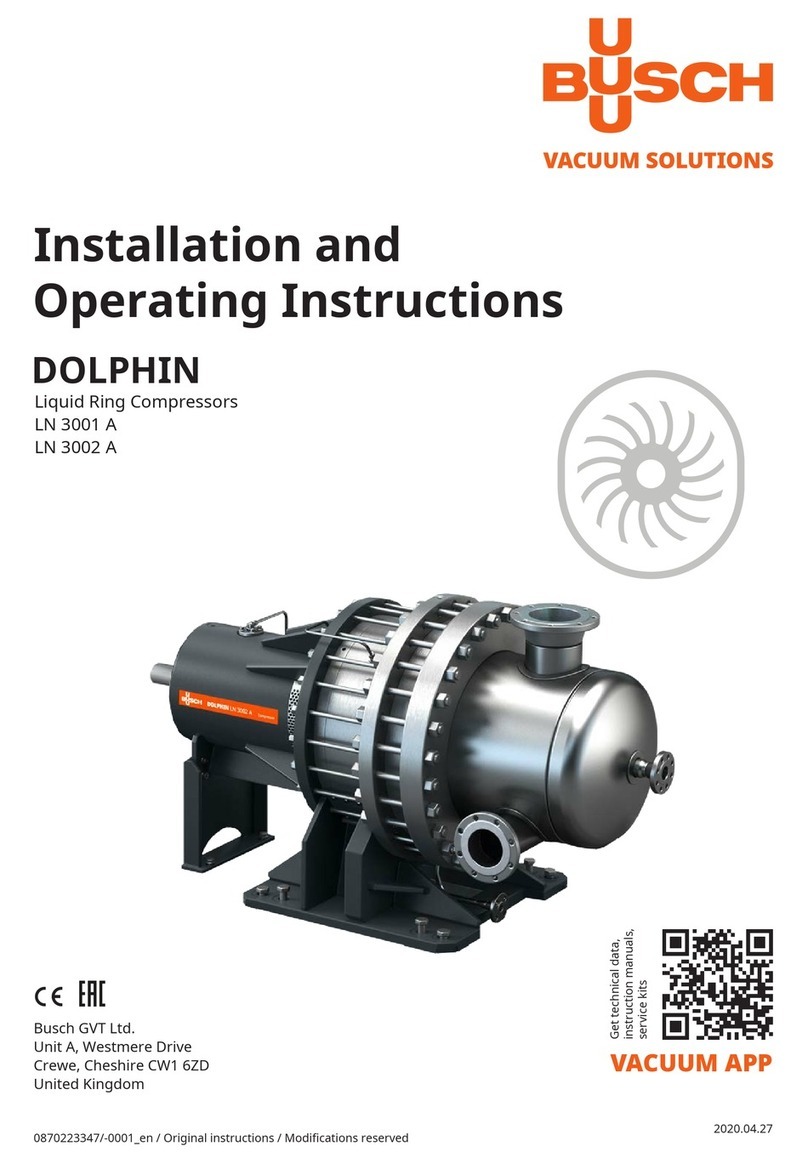
BUSCH
BUSCH DOLPHIN LN 3001 A Installation and operating instructions
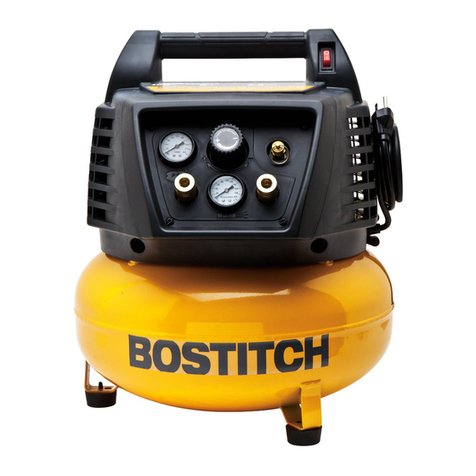
Bostitch
Bostitch BTFP02011 Operation and maintenance manual
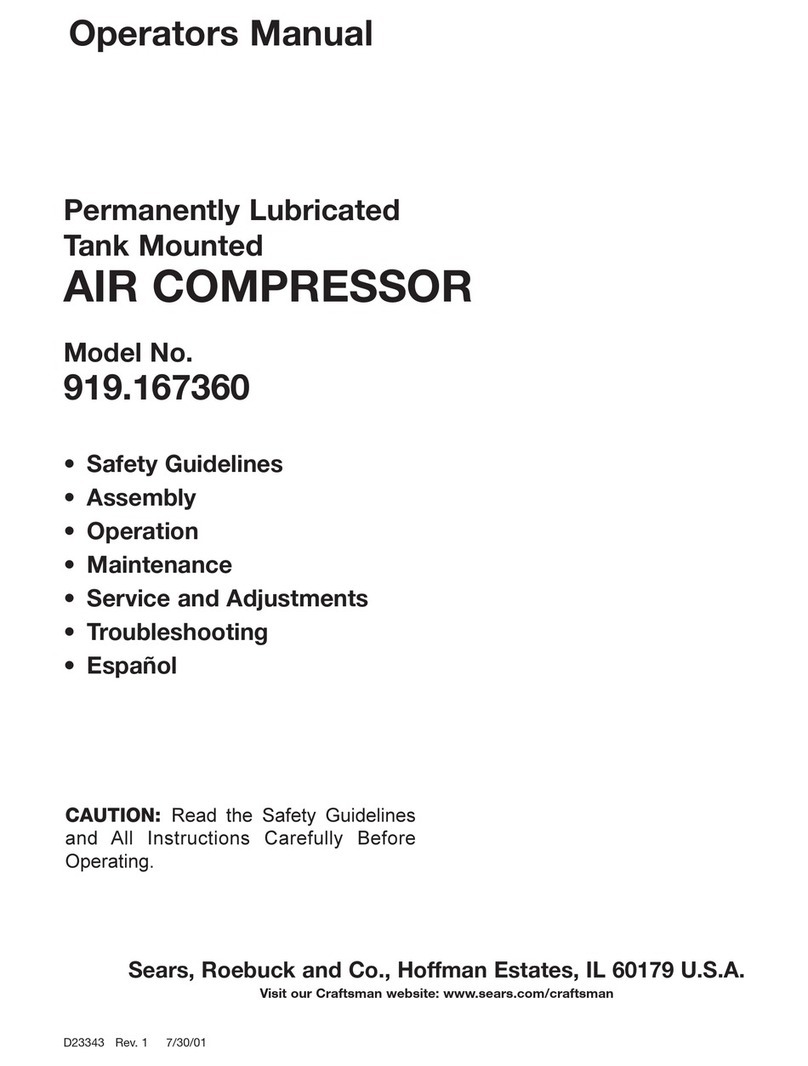
Craftsman
Craftsman 919.167360 Operators Operator's manual

Mattei
Mattei BLADE 15 Series Instruction, use and maintenance manual
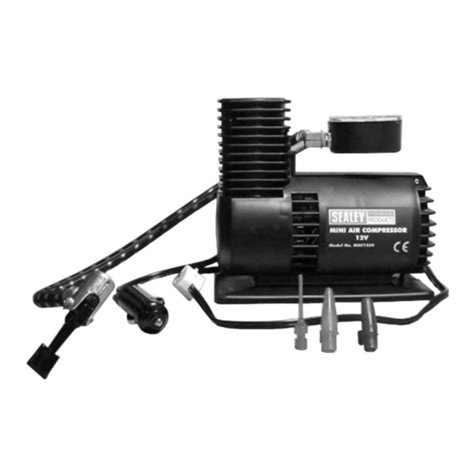
Sealey
Sealey MAC1250 instructions

Doosan
Doosan NHP1500WCU-T3 Operation and maintenance manual

